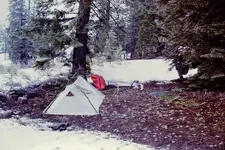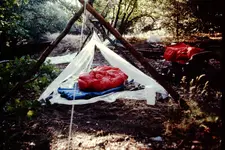Ragnor,
Bill and Jeff have given you some good advice. IF you are going to be "working" in your gear then it needs to be TOUGH! Then in the snow you MUST LAYER your clothing and as you warm up from exercise/work peel off the layers as it is a SIN TO SWEAT in winter conditions! Sweat pulls the heat away from your body as it evaporates and the moment you stop generating heat from hard exercise your clothing becomes cold and that can kill you!! Snow shoeing, hiking, working are all labor intensive and if you do not wear layers that are easy to remove and replace then you will not last long. This includes layers of gloves/mittens. Gortex is great, delicate, expensive though if you happen to be anywhere around a bunch of 'thrift stores' you might check them out for winter gear used on the Alaska pipeline. I happened on a Gortex jacket that way, the outer layer is a tough nylon/cotton blend so it will take some abuse and of course the Gortex is bonded to another layer of cloth then it has a 300 grade removable inner jacket I think I paid $20 for it. Best purchase I've ever made!
I've also purchased some North Face, Eddie Bauer, Sierra Design and Mountain Hardware jackets and layers. They all work but pure nylon melts when an ember from the fire pit pops onto the nylon! Goose down absorbs water and when wet it is not much use at all. Stick with the better man made insulating fiber fills as they will serve you well, they will be somewhat heavier, a bit stiffer to move in but even when wet they will keep you warm.
Winter is unforgiving, you make a mistake in winter and it will Get You right now! Staying warm and staying dry will keep you comfortable and alive. I've slept out in the open in winter: space blanket on the snow, foam bad, goose down sleeping bag and me inside it and I've been most comfortable. We would cross country ski with ~ 35 lb packs including a tent for a three day outing. The only time I had trouble was when I did not pay attention to the amount of body heat my clothing was absorbing so I perspired a fair amount - Sweating in the Winter is a Sin! As soon as we stopped to setup camp I became chilled, by the time we got the floor of the tent stabilized enough so we could carefully crawl into it, I got into both my sleeping bags with my clothes on. I was shaking badly!! After some time I fell asleep, later I woke up to the fact that I was inside an oven and was sweating again. The tent made a big difference as it kept the wind off of us. I pulled out the liner bag and got off most of my clothing and went back to sleep. Things were a little soggy in the morning but I was careful all day long.
Picture this, there are several feet of snow on the ground when you step on it you sink up to your knee. The same thing happens IF one does not support the floor of the tent. Yes we stomped the surface with our ski's (you would do this while wearing your snow shoes) however it is not nearly compacted enough to allow you to setup your tent and crawl into it. We were lucky that we did not tear the floor of the tent as we sank into the snow. The solution was to pull off a whole bunch of pine boughs, layer them on the surface of the snow and then put the tent on top of the pine boughs and then still be very careful about going in and out of the tent. Crisscross the layers of the pine boughs for better support!
NEVER start any type of stove in the tent! Tents are flammable, todays tents are made of plastic fabric and when that is burning it is very sticky. Picture sticky burning hot stuff all over your body and when you pull it off it removes your skin.
Snow caves work but if the snow is not deep enough it is tough to build one.
Read up on survival in snow conditions! Fire starters are a must! Get a bunch of the PAPER egg cartons, remove the lid, pour/fill dry Saw Dust into the egg holding cups, pour melted wax onto the saw dust till it wets the paper carton, do this for all twelve/eighteen egg cups and then let it cool for several hours before trying to separate each egg cup. This saturated paper (think waterproof) and saw dust makes for a tremendous fire starter even in rain. I carry several butane lighters in my kit bag just incase one should fail (which I've never had even one fail, run out of fuel but never fail) If it fails and you only have one then you are in a world of hurt. How to start a fire in a sopping wet forest? Pull off a significant quantity of pine limbs, shake the water from them, break off small sections of the THIN limbs with lots of green needles on them. Light the fire starter, place several pieces of the short sections of pine limb w/needles onto the burning fire starter, Snapple-crack-pop-Poof the limb burns ah yes pine tar is still there even in winter. Of course along with the pine limbs you will need other Firewood so get a good bunch of this setup before lighting the fire starter. I've used this method to light a fire from soaked wood and it works, lots of steam but it will burn and once burning keep feeding it as it is your friend. Oh, one item of importance, make certain that there is no snow in the tree above the fire as the heat from the fire will melt the snow causing it to "rain in camp right around the fire".
Keeping yourself alive in the winter is harder than in summer. There are many more obstacles that you cannot see because of the snow. Everything is slippery because of the snow or water so treat your snow shoes with care as they are your best friend and will keep you above the obstacles. Trudging through snow without the snow shoes is really a lot of work, however I suspect you already know this.
Winter adventures are unique and beautiful as long as you stay dry, warm, fed and can get out of the weather in a sturdy tent.
Best of success with your adventure......................63bkpkr
I've "heard" that alcohol thins the blood and reduces ones ability to stay warm












